
The role of chief experience officer (CXO) has been gaining prominence within the corporate hierarchy in recent times as organizations have realized the significance of robustly retaining customers against the onslaught of market disruptors. This is amplified by the fact that consumer behavior has become more discerning as eCommerce channels have pitched the “distinguishing” virtues of COAST (Convenience, Options, Accessibility, Safety, Timeliness)—especially, in precarious times such as the lockdown pertaining to the COVID-19 pandemic—against the prevalent ambience-driven personable norms of brick-and-mortar settings.
Consequently, progressive organizations are projecting the CXO role as a testament to their resolve in being a formidable competitor in the market. However, most are lured by the slogan of singular focus on the customer that panders to exclusivity while marginalizing the holistic approach driven by the inclusivity of all key stakeholders. This increases the risk factor for businesses trying to compete in the precarious dynamics of the Digital Age, especially, when catastrophes like the COVID-19 pandemic significantly test the reliability of the customer base necessary to generate sustainable revenues. Such a constricted view of customer focus has already tarnished the fabled reputations of industry titans such as Boeing (https://lnkd.in/dZFJ6db), General Electric (https://lnkd.in/dppMshJ), and Johnson & Johnson (https://lnkd.in/dxajqdJ), while the list keeps growing (https://lnkd.in/dQt38qZ), with the financial industry being one of the worst culprits (https://lnkd.in/dXfqbDZ).
The following table shows some of the differences between the two approaches:
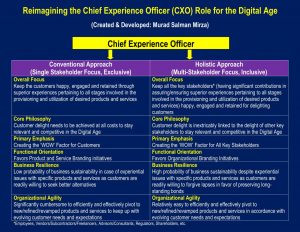
Let’s take a deeper dive into the multi-stakeholder approach within the realm of eCommerce, the hallmark of the Digital Age, and why it is a better alternative to the single stakeholder path that has consistently failed to deliver the hyped promises as a protrusion of marketing initiatives. A simple way to visualize the relationship between customer expectations and customer experiences is as follows:
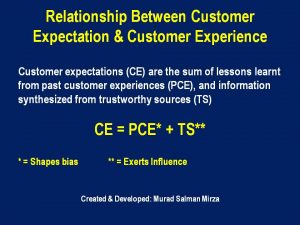
The aforementioned depiction is a qualitative characterization of the relationship between customer expectation and customer experience. If the Past Customer Experiences (PCE) with respect to a certain eCommerce provider are equal to zero (i.e., a first-time interaction), then the Customer Expectations (CE) are totally reliant on Trusted Sources (TS) (e.g., family, friends, acquaintances, prominent multimedia sources, marketing material from the eCommerce provider, customer’s own self-confidence on random research, or experiences with other eCommerce providers, etc.). On the other hand, if both PCE and TS are equal to zero, then the customer is in the exceedingly rare position of proceeding with no expectations and is exposing themselves to an uncalculated risk.
The interaction between an eCommerce provider and the customer can be illustrated through “The Eyeglasses Model” as follows:
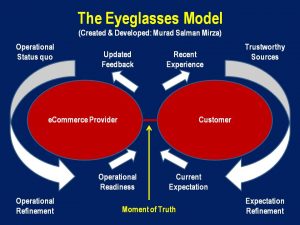
The “Moment of Truth” depicts the stage where customer expectations are gauged against actual customer experiences that take place between an eCommerce provider and the customer through an online channel, (e.g., Website, app, personal digital assistant (PDA), Virtual Reality (VR), Augmented Reality (AR), hologram, etc. ). The left side shows the readiness and refinement of the operational cycle for the eCommerce provider, while the right side shows the initial and subsequent refinement of the expectation cycle of the customer, before and after the interaction between the two parties.
A typical example of a customer’s thought process involved in the purchase of an item from an online shopping site is as follows:
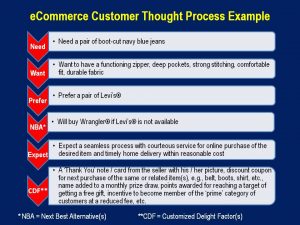
This example shows how critical it is for all the key stakeholders to be onboard in terms of providing a truly gratifying customer experience. This can be realized in further detail by examining the role played by a sample of the key stakeholders in the respective transaction, as follows:
Employees
The employees at the respective organization will serve various roles (e.g., IT experts, system administrators, customer service representatives, distribution center staff, etc.), despite technology being at the forefront of an online transaction. Every one of them needs to be fully committed to upholding the service standards for the provisioning of a pair of jeans, for example. However, that might not happen due to serious fissures in employment relationships, including bullying supervisors, harassing peers, health and safety lapses, contractual conflicts, organizational politics, misgivings between the union(s) and the leadership, etc. Sensitive customers are likely to take note of such incidences, especially, when they are reported in the media, such as a high rate of COVID-19 infections among Amazon employees (https://lnkd.in/dCB3Jvw), in terms of formulating their decisions of associating with the relevant eCommerce provider for future transactions.
Vendors/Subcontractors/Freelancers
The professionals involved in the timely provisioning of a pair of jeans—including manufacturers, delivery drivers, software developers, etc.—are another important element of the customer experience equation since if they are not treated or supervised in a fair manner, it can adversely impact the service standards (e.g., inability to replenish stocks in a timely manner, poor functionality or lack of timely and quality upgrade of the software behind the online operations, delay in delivery to the customer due to various “unavoidable” reasons, etc.). This can hurt the organization’s image in the eyes of customers since they deem everyone who interacts with them directly/indirectly is working for the organization. Indeed, several global brands received a significant hit to their reputations when the worst disaster in history of the garment industry happened in Bangladesh (https://lnkd.in/dAqtasj).
Advisors/Consultants
Advisors/consultants would have been hired for their specific expertise by the organization in certain areas, such as streamlining services delivery processes, developing data analytics skills, insightful research on consumer behavior, etc., with the expectation that they will provide guidance on gaining a significant edge over the organization’s competition. However, their ability to deliver on expectations or even excel in them depends upon how well they are treated by the organization (e.g., refraining from scope creep (https://lnkd.in/dEr-etS), behavior of their primary contact at the organization, cooperation from functional heads involved in the project, receptiveness of organizational leadership to progressive recommendations, timely payment for their services, etc. ). Consequently, the organizations has to be mindful of how its engagement with advisors/consultants is managed since that can have a profound impact on the quality of the customer experience.
Regulators
Pertinent rules and regulations enforced for the protection of consumers are vital to assuring and ensuring that the rights and privileges of the public are not transgressed upon in the interest of unsavory business gains (such as earning higher margins by maliciously exploiting loopholes in the labor laws). Therefore, the organization is legally/ethically bound to adhere to applicable rules and regulations, including those relating to sourcing from reliable suppliers who are not using poisonous chemicals in the manufacture of jeans and/or using child labor, storing the jeans in a suitable environment in the distribution center, ensuring clear conditions of sale and warranty printed and visible for the customer, etc. Consequently, passing announced/unannounced regulatory audits with flying colors provides a solid grounding in the provisioning of wonderful customer experiences as it clears the path for progressive growth without the risk of being flagged for violations that may hurt the organization’s reputation as a responsible corporate citizen, especially, in the eyes of civic-minded customers.
Shareholders
Shareholders usually prize organizations that are capably led and demonstrate consistent ability to meet performance targets while being a responsible corporate citizen. Such qualities also act as a buffer against activist shareholders vying for leadership change that is more in line with their way of running organizations. A CXO can be a powerful ally of an embattled CEO in terms of substantiating efforts for sustainable productivity and growth leveraged upon a loyal customer base that is magnetized by the consistent fulfillment of promises kept in terms of the desired service standards—e.g., on a simpler level, buying a pair of jeans online through a seamless process. Savvy shareholders value an organization’s ability to resolutely sustain its ability as a “going concern” in good and bad times. As such, positive word of mouth emanating from shareholders in terms of their own wonderful experience reverberates across the industry with watchers/opinion leaders/consumer advocates serving as a catalyst for current customers to keep benefiting from the organization’s products and services while offering an attractive invitation for new customers to join the “circle of trust” engendered by the positive corporate reputation.
A prudent approach to achieving success as a CXO is to always remember the golden rule that “a silent customer is not necessarily a satisfied/delighted customer.” This can be visualized as follows:
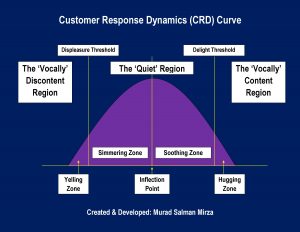
Food for Thought
The foundations of a great customer experience are paved with the optimized goodwill of all key stakeholders who are fervently committed and harmonized to the unifying goal of facilitating an organization in terms of excelling in its initiatives to delight customers. Consequently, the primary question for a CXO seeking to propel their organization to the forefront of excellence in customer experiences is: Am I a uniter or a divider?




